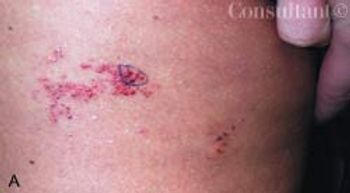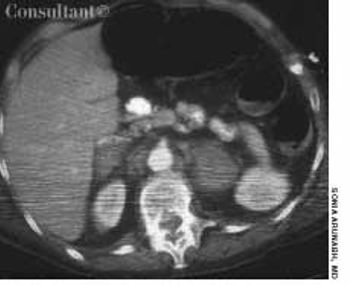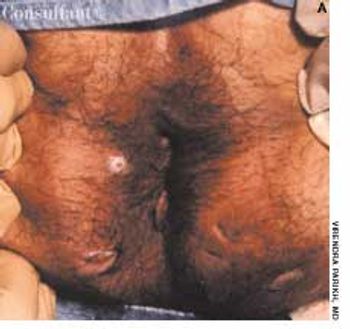
Frequently, I have seen cerumen removal with water picks and syringesresult in trauma, including significant tympanic membrane perforation,and infection; thus, I no longer use these devices.

Frequently, I have seen cerumen removal with water picks and syringesresult in trauma, including significant tympanic membrane perforation,and infection; thus, I no longer use these devices.

Q:Should I prescribe isoniazid prophylaxis for an elderly patient withmultiple health problems who recently converted from negative topositive tuberculin status?

For 10 years, a 22-year-old woman had had an erythematous, translucent patch of grouped blisters on her left thigh. A recent increase in the size of the patch prompted the patient to seek treatment. There was no burning or tingling at the site. The patient reported that the erythema occasionally cleared; however, the blisters always remained. She denied fever, weight loss, and other constitutional symptoms.

A Young Boy With High Fever and LethargyA 5-year-old boy is brought to the emergency department(ED) by his parents. They report that, for thepast week, the child has had a high fever (temperatureup to 40oC [104oF]), generalized weakness, lethargy, andlack of appetite. The boy’s eyes are bloodshot and he hasrefused food and drink. The child has no history ofcough, shortness of breath, hematemesis, melena, headaches,vision problems, or seizures. He has not been incontact with sick persons, has not traveled abroad, doesnot have a pet, and is not taking any medications. His immunizations are up-to-date.

The diagnosis of osteoarthritis (OA) is primarily clinical. Key historical clues to idiopathic OA include patient age greater than 45 years, joint pain that increases with activity and is relieved with rest, morning stiffness of 30 minutes duration or less, and involvement of one or more of the following: hips, knees, cervical or lumbar spine, basilar thumb joints, interphalangeal joints of the hands, midfoot joints, and first metatarsophalangeal joints.

Back pain is second only to upper respiratory tract infection as the most frequently reported illness in the United States; up to 20% of Americans experience back pain each year.

ABSTRACT: Topical agents can provide temporary relief from osteoarthritis symptoms with little or no risk. Acetaminophen is first-line oral therapy. Be alert for risk factors for NSAID-induced GI toxicity, such as concurrent use of prescription and OTC agents. Tramadol, narcotic analgesics, muscle relaxants, and antidepressants are options when NSAIDs are ineffective or contraindicated. Intra-articular injections of corticosteroids or hyaluronan are appropriate for patients who have a single joint exacerbation. Total knee and total hip arthroplasty are considered the most effective surgical interventions.

A 53-year-old man has hadmalaise, intermittent cough, and occasionalfever and night sweats for 2weeks. He has also lost some weightduring this time but denies hemoptysisand sputum production; he hasnot traveled abroad recently. His onlysignificant medical condition is hypertension,which is well controlled withmedication.

Primary care providers are seeingan increasing number ofpatients who have snakes orbarbwire coiling around theirarms or gold rings danglingfrom their eyebrows and navels. Tattooingand body piercing are particularlypopular among adolescents andyoung adults-many of whom may notbe aware of the possible medical complicationsof these ancient practices.

ABSTRACT: Unless the cause of back pain is obvious, order anteroposterior and lateral radiographs of the spine, a complete blood cell count, erythrocyte sedimentation rate, and urinalysis. If you suspect infection, tumor, or bony abnormalities, obtain an MRI or CT scan. MRI has surpassed bone scanning as the gold standard for diagnosing spinal infections, because it confirms a specific anatomic diagnosis. Spondylolysis and spondylolisthesis are 2 of the most common causes of back pain in adolescents; the diagnosis is made with plain radiographs, which show slippage on the later-al view in patients with spondylolisthesis and fracture through the pars interarticularis on the oblique views in those with spondylolysis.

The most common blood-borne infection in the United States, hepatitis C is also one of the leading causes of chronic liver disease in this country. About 35,000 new hepatitis C virus (HCV) infections are diagnosed each year; by 2015, the number of persons with documented HCV infection is expected to have increased 4-fold from what it was in 1990.

ABSTRACT: Patients can greatly reduce the risk of traveler's diarrhea by drinking only bottled water and eating only hot foods prepared in sanitary conditions or peelable fruits and vegetables. Antibiotic prophylaxis for traveler's diarrhea is no longer routinely recommended; reserve it for patients who may have to consume food and beverages of questionable safety, those with reduced immunity, and those likely to experience serious consequences of illness. Adequate hydration is the first step in treating traveler's diarrhea. Drug therapy-loperamide or fluoroquinolones in adults and bismuth subsalicylate or azithromycin in children-can ameliorate symptoms and speed recovery. Recommend that patients who are prone to motion sickness take an antiemetic/antivertigo agent before symptoms begin. Acetazolamide can be used both to prevent and to treat altitude sickness. Contraindications to air travel include a resting oxygen saturation of less than 90%, pregnancy of more than 36 weeks' duration, pneumothorax, recent myocardial infarction or chest or abdominal surgery, active infectious diseases, and poorly controlled seizures or sickle cell anemia.

A 78-year-old man presented to theemergency department with a 3-weekhistory of progressive shortness of breathand cough with blood-streaked, yellowishsputum. The patient had dyspnea onexertion limited to 2 blocks, 2-pilloworthopnea, paroxysmal nocturnal dyspnea,and nocturia. Neither fever norchills were present. He had lost 7.2 kg(16 lb) during the last year.

Smoking-related diseases have reached epidemic levelsamong women in the United States. Since 1980, neoplastic,cardiovascular, respiratory, and pediatric diseases attributableto smoking-as well as cigarette burns-havebeen responsible for the premature deaths of 3 millionAmerican women and girls. Lung cancer is now the leadingcause of cancer-related deaths among US women; itsurpassed breast cancer in 1987.1

A 77-year-old man is brought to the emergency department after severaldays of illness that began with fever, nausea, emesis, and headache. Muscleweakness and associated myalgia developed; the weakness became so severethat the patient needed help to get out of bed and walk to the bathroom.The day before he came to the hospital, he slept much of the time and wasdifficult to arouse.

A 44-year-old man with type 2 diabetes was recently hospitalized for an acuteexacerbation of pancreatitis. This was his seventh admission for the conditionwithin the past several years. Although imaging studies revealed no calcifications,the hospitalist suspected that acute relapsing pancreatitis was evolvinginto chronic pancreatitis.

A 48-year-old woman was admitted to the hospital with deep venous thrombosis of the right leg. She had a history of non-Hodgkin lymphoma, which was in remission. The patient had been a heavy smoker for many years.

Fourteen months of intermittent, foul-smelling, perianal discharge prompted a 45-year-old man to seek medical evaluation. He also complained of occasional bright red rectal bleeding and soreness of the perianal region; he denied fever.

A 7-year-old black girl comes toyour office with a 10-week historyof scaling and scalp redness,and hair loss. About 3 weeks beforethe visit, the child’s motherfirst noticed a boggy, drainingyellow plaque on her daughter’sparietal scalp. A different physicianprescribed ketoconazoleshampoo. At 1-week follow-up,the symptoms had not abated;the clinician then prescribed oralcephalexin as well as a topical mixture of the antifungal agent, clotrimazole, and the high-potency topicalcorticosteroid, betamethasone. After 2 weeks of therapy, the symptoms were no better.

A 69-year-old retired accountant presents with a 2-month history of daily headaches. The pain is moderate, constant,global, pressure-like, and occasionally pulsating; it is sometimes exacerbated when the patient lies down. He denies nauseaor vomiting, ocular symptoms, weakness, or sensitivity to light. His wife reports that years ago he experienced throbbingheadaches regularly.

ABSTRACT: A key objective in the follow-up of women with a history of breast cancer is the detection of local and distant disease at a curable stage. Regular clinical examination and yearly mammography are the standard of care. No consistent evidence supports annual chest radiography, bone scans, or tests of serum tumor markers. Order laboratory or diagnostic tests only if indicated by clinical findings. Advise women to report new symptoms promptly rather than waiting for the next scheduled examination. Some evidence supports the use of venlafaxine for tamoxifen-associated hot flashes. Despite the increased incidence of endometrial carcinoma in women taking tamoxifen, routine endometrial biopsies are not recommended. Most experts advise that women with a history of breast cancer who wish to have a child wait 2 to 3 years before becoming pregnant.

According to the CDC, last year's influenza season in the United States was mild to moderate.1Influenza activity increased in mid January and peaked during mid to late February. The percentage of deaths associated with pneumonia and influenza exceeded the epidemic threshold for 5 consecutive weeks. Influenza A (H3N2) viruses predominated, although toward the end of the season, influenza B viruses were identified more often than influenza A viruses.

During a routine office visit, a 64-year-old woman who has had type 2 diabetesfor more than 10 years complains of increased pedal edema. The edema is minimalon awakening and worsens throughout the day.

The mother of a 6-year-old child brings her to your office becauseof a pruritic rash that has been present for several days. The rash did not respondto hydrocortisone cream and has continued to spread along the patient’sleft side.

I have a 74-year-old male patient who has peeling lips and recurrent painful aphthousulcers.